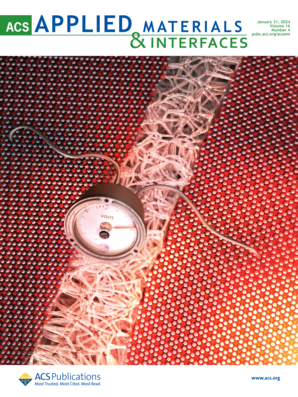Attapulgite-Assisted In Situ Anchoring of Ultrasmall Ag Nanoparticles for Enhanced Eradication of Multidrug-Resistant Bacterial Biofilms and Accelerated Wound Healing
IF 8.3
2区 材料科学
Q1 MATERIALS SCIENCE, MULTIDISCIPLINARY
引用次数: 0
Abstract
Silver nanoparticles (Ag NPs) have emerged as a promising solution to combat biofilm-related infections caused by multidrug-resistant bacteria. However, their practical application remains limited due to their tendency to aggregate and exhibit high toxicity at elevated concentrations. Here, we developed a Citrus limon peel water extract-mediated hydrothermal process to facilitate the heterogeneous nucleation of Ag NPs on attapulgite (APT) nanorods and prepared Ag/APT nanocomposites with ultrasmall Ag NPs (<2 nm) uniformly anchored on APT nanorods. Ascorbic acid and polyphenols in Citrus limon peel extract acted as electron donors to reduce Ag+ to Ag0, while the interfacial interaction of APT nanorods induced heterogeneous nucleation and confined the growth of Ag nanocrystals, resulting in ultrasmall Ag NPs. As a result, due to the synergistic effect of the targeted biofilm-binding affinity of APT nanorods and the siginificantly increased specific surface area of Ag NPs conducive to the release of Ag+ ions, the obtained Ag/APT nanocomposites exhibited enhanced eradication activities on antimicrobial-resistant bacterial biofilms and accelerated wound healing in MRSA-infected wound models. Additionally, attributing to the low dosage of Ag, Ag/APT exhibited exceptional biocompatibility both in vitro and in vivo. This work provides a simple and green strategy for the preparation of highly active Ag-based antibacterial nanomaterials and sheds new light on the development of advanced antimicrobial agents for wound healing.

凹凸棒石辅助的超小银纳米颗粒原位锚定增强了多药耐药细菌生物膜的根除和加速伤口愈合
银纳米颗粒(Ag NPs)已经成为对抗多重耐药细菌引起的生物膜相关感染的一种有希望的解决方案。然而,它们的实际应用仍然有限,因为它们倾向于聚集,并在高浓度下表现出高毒性。本研究采用柑橘柠檬皮水提物为介质的水热工艺,促进银纳米粒子在凹凸棒上的非均质成核,并制备了超小银纳米粒子(2 nm)均匀锚定在凹凸棒上的银/APT纳米复合材料。柑橘柠檬皮提取物中的抗坏血酸和多酚作为电子供体使Ag+还原为Ag0,而APT纳米棒的界面相互作用诱导了Ag纳米晶的非均质成核,限制了Ag纳米晶的生长,从而形成了超小的Ag纳米晶。因此,由于APT纳米棒的靶向生物膜结合亲和力和Ag NPs显著增加的比表面积有利于Ag+离子的释放的协同作用,所获得的Ag/APT纳米复合材料对抗菌耐药细菌生物膜的根除活性增强,并加速了mrsa感染伤口模型的伤口愈合。此外,由于Ag的低剂量,Ag/APT在体外和体内均表现出优异的生物相容性。这项工作为制备高活性银基抗菌纳米材料提供了一种简单、绿色的策略,并为开发用于伤口愈合的高级抗菌药物提供了新的思路。
本文章由计算机程序翻译,如有差异,请以英文原文为准。
求助全文
约1分钟内获得全文
求助全文
来源期刊

ACS Applied Materials & Interfaces
工程技术-材料科学:综合
CiteScore
16.00
自引率
6.30%
发文量
4978
审稿时长
1.8 months
期刊介绍:
ACS Applied Materials & Interfaces is a leading interdisciplinary journal that brings together chemists, engineers, physicists, and biologists to explore the development and utilization of newly-discovered materials and interfacial processes for specific applications. Our journal has experienced remarkable growth since its establishment in 2009, both in terms of the number of articles published and the impact of the research showcased. We are proud to foster a truly global community, with the majority of published articles originating from outside the United States, reflecting the rapid growth of applied research worldwide.
 求助内容:
求助内容: 应助结果提醒方式:
应助结果提醒方式:


